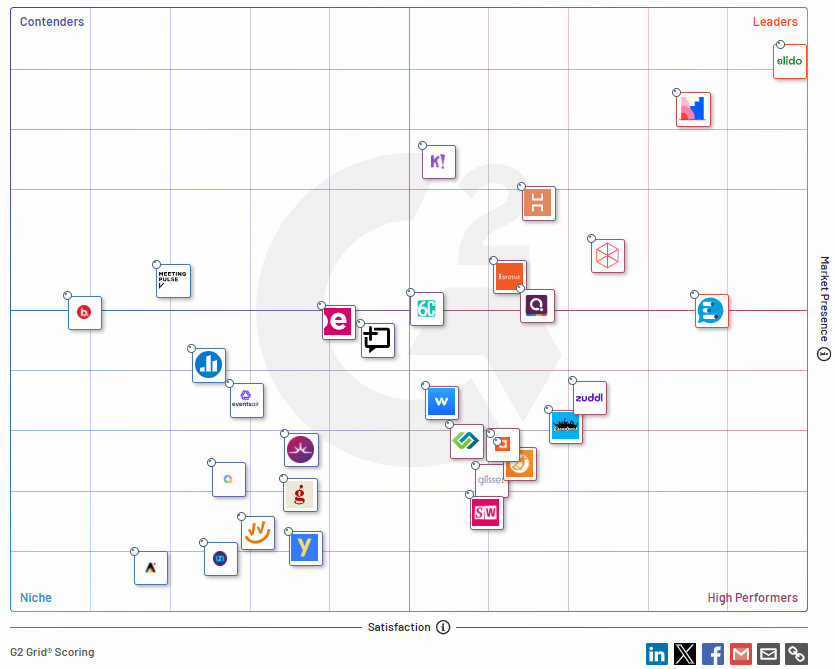In this tutorial we’re going to show you three ways to run a poll in a Teams meeting. Each option works in slightly different ways with pros and cons to each. The best solution to use depends on your requirements and what’s important to you.
The two options are:
- Use the built-in polls option for Teams Meetings
- Use StreamAlive to run Teams polls (and other interactions) powered by the audience chat
- Use an audience engagement tool which requires your audience to navigate away from your Teams meeting
1. Built-in polls in Teams meetings
Pros:
- Audience stays focused in your presentation
- Attendees can vote in the poll before the meeting starts
- Can make votes anonymous
- Lots of templates to choose from
- Multiple choice options
Cons:
- Not available ‘out of the box’
- Only available on Business plans
- Need to re-add the poll app for each meeting
- Not real-time, have to vote first to see response
- No customization options
- Basic, Excel-based reporting
To use Teams built-in polls in a regular Teams meeting you need to be on a Microsoft Business Plan which currently starts at $48 per year per user.
If you have a free Teams account and want to run a poll in your meeting, you need to check out StreamAlive or one of the other third party apps.
Our experience with Teams polls: Once we were set up with a paid Teams business account (we use Google Workspace and Slack) we were able to try out the polls option in Teams Meetings.
In our earlier review of the built-in Zoom polling options we found the poll feature to be an afterthought. That’s not the case with Microsoft’s Polls app which you have to add to the meeting.
The Polls app has lots of pre-written polls, quizzes, wordclouds, and rating polls available for regular work meetings. This makes it very easy to get a poll up and running. Adding a poll also had customization options like adding an image, although the UI of the poll didn’t have any customization.
Performance-wise, the polls work the way you would expect and we liked the idea of sharing a poll with attendees before the meeting starts.
The post-event reporting is relegated to an Excel file with the raw voting data which is disappointing if you wanted to share the results publicly as Excel doesn’t make the prettiest of charts. We liked that the poll results was available in our Teams channel after the meeting, but there didn’t appear to be an option to download the chart to share on other platforms.
There’s no option to immediately run a poll in a Teams meeting. Instead, you have to add a poll to the meeting before it starts.
This is where we ran into our first bit of trouble. We created a meeting but couldn’t find anywhere to add the poll.

It turns out that you have to create the meeting, save it, AND THEN COME BACK to the meeting you just created. This will give you some menu options. From this page you need to click the + icon.

This opens up a window where you can search for apps to add to your Teams account. The first option is Polls, which is convenient!

Less convenient is that every time you want to run a poll in a meeting you have to repeat this process to add the Polls app to the meeting.
The Polls app will load a page where you can add, edit, and manage polls. You have the option to create a new poll or use one of the many pre-written polls that are available to you.

You can set up your polls before your meeting starts and share them with the attendees before they join the meeting, which is handy.
You can also create a poll while in the meeting if you get a sudden flash of inspiration or the team needs to make a democratic decision.
When creating a poll in Teams you have multiple types of polls to choose from. In this tutorial I’m just going to show you the basic multiple choice poll.

The poll lets you add custom images for the poll and for the poll options which is a nice touch at letting you customize it. However, it doesn’t let you customize the colors and UI. I also liked that it had quick select buttons to add “all of the above” and “none of the above” options.
Use the settings options to say whether the poll is anonymous or not, and whether the results will be shared with respondents. Anonymous polls tend to get more honest (read: brutal) answers.

When you are done adding your question, options, and customizations, you can save the poll to run it later or launch it straight away.

Everyone in the meeting gets a pop-up notification on their screen to let them know that there is a poll for them to vote in.

Attendees can’t see how people are voting until they have voted, which is either a positive or negative depending on how you look at it. When the attendee has cast their vote they can click done and this hides the poll to one side.

You can keep your polls running throughout the duration of your meeting, but when you are done with the poll you can close it so no further responses are allowed.

After your meeting has finished, your poll results will be available in the meeting chat. You can choose to share the results in a Teams channel or download the raw date in an Excel file.

There’s no option to save your results in an image file which can be shared in different places, so instead you have to download the raw results in an Excel file and create your own charts - and Excel is not known for producing eye-catching graphs!

And that’s it, that’s how you run a poll in Teams using Microsoft’s Polls app.
Next up, we’re going to look at how to use StreamAlive to run a poll in a Teams meeting where the respondents can vote by simply typing in the chat.
2. Using StreamAlive to run Teams Meeting polls
Pros
- Free - StreamAlive is free for Teams meetings upto 30 participants
- Simple for the audience to use - they just type it in the chat
- Use AI to generate poll questions relevant to your session
- Customize brand colors
- Keeps your audience focused on your presentation screen
- Run other types of audience interactions like word clouds, spinner wheels, interactive maps, etc.
- Beautiful post-event reports
Cons
- Voting is not anonymous
- Polls are not embedded in your Powerpoint or Google Slides presentation
StreamAlive polls for Teams meetings allows your audience to vote in your polls using the chat. By typing 1, 2, 3, etc. in the chat they can vote for a poll option.

On the free plan, upto 30 participants can vote in your polls, making it ideal for most business meetings. For larger audiences, pricing plans start at $19/mo for 100 participants.
Sign up for a free account if you don’t already have one and login.
User’s experience with StreamAlive: I love that I can interact with my audience easily. I love the map that shows where all the participants are from and the ease with which I can handle questions during my live presentation. Even more impressive is that I can combine a live online event with a live in person audience. This allows everyone to participate equally. The Tetris Squares are my favorite part - they allow me to customize my presentation to the needs of the people in the room. Customer support is very responsive. I really would never host another meeting without using this. Susan Shangle, founder of Susation Consulting
Let’s see how easy it is to set up a Teams meeting poll using StreamAlive.
There are two ways of running a poll in Teams meeting using StreamAlive.
- Plan you poll (or polls) in advance
- Fly by the seat of your pants and run an ad-hoc poll during your meeting
I like to plan in advance, so I’m going to show you how to create a poll before your Teams meeting starts and run that poll during your meeting.
And then, I’ll show you how to do the fly-by-the-seat-of-your-pants poll and create one in your meeting.
First, let’s create an interactive presentation from a blank slide (we can talk about creating an interactive presentation with AI another time).

Add a poll.

Enter your question and your answer options.

If you’re feeling fancy, you can even customize your poll with your brand colors.

If you need assurances that what you’ve done is the right thing, there’s a built-in preview that simulates how your poll will look for your audience.

If you’re happy with that, it’s time to connect StreamAlive to your meeting.
In my example I’m going to use the Present now option, but you can also schedule for later if your meeting is taking place later.

Select Teams…

…and you’ll be invited to authorize and connect your account.

StreamAlive will pick up your scheduled meetings and you just need to select which meeting you want to add the polls to and click the Present button.

The StreamAlive website opens a new page called Live Presentation. It is the canvas on which your polls (and other audience interactions) appear. Share this screen like you normally would for a presentation.

On the Live Presentation screen, you’ll find the polls that you have created. Click on one of the polls to start the interaction. The moment it appears on the screen your audience will be able to vote in the poll by typing 1, 2, 3, etc. to correspond with the option they are voting for.

When your meeting is over, you can view charts, reports, and stats about your meeting. StreamAlive will show you how many comments were received while your poll (or other audience interaction) was running.

You can even download the poll graphic as an image or share to social media.

You can even see who voted and how the interaction spiked engagement in your meeting.

StreamAlive also automatically captures and curates questions from the chat so you can find them in one place. Although Teams has a Q&A feature for attendees to ask questions, we’re heard plenty of feedback from presenters that tell use many people forget to use it or simple ignore it and enter the question in the chat.

If keeping things simple for your audience and keeping their attention on your presentation is important for you, then StreamAlive is a good choice for running Zoom polls and other interactions.
Sending people to a different browser tab or asking them to look at their phone
Pros:
- Anonymous voting is possible
- Multiple choice polls and surveys
- Run different types of interactions like word clouds and quizzes
- Nice interfaces, often with cute and playful animations
- Lots of customization options on the look and feel of the polls
- Nice post-event reports and charts
Cons:
- Send your audience away from your presentation
- Feels like the poll is an afterthought as you need to stop your presentation and ask the user to look at something else
- Forces your audience to toggle between tabs
- The host has to toggle between tabs to show their presentation slides and the results of the poll
- Various limitations on free plans from the small number of polls you can run to the limited number of participants
Every other audience engagement tool that we’ve come across to run polls in a Teams meeting follows the same format:
- Presenter shares a QR code or link on the screen with a pin number
- The audience opens the link in their browser or phone and enters the pin
- The audience is now looking at a poll, not at the presentation and voting
- The audience then switches tabs to come back to the presentation
G2 is full of these types of solutions. Some of them like Slido and Mentimeter are really popular.

Our experience: We tried Kahoot in an all-hands Teams meeting and found it to be a very fun way to add some entertainment at the end of the meeting when everything had been wrapped up. It was easy to set up and we liked the customization options in the polls. The visuals are very cute. We liked that the quiz brought out the competitive nature in people thanks to the scoring and leaderboards - it definitely kept people’s attention. However, for the main part of the meeting we didn’t think that sending people away from the CEO’s presentation was a good idea.
If you are happy to send people away from your presentation to run a poll in Teams, then any one of these solutions would work.
One of the benefits of using a third-party tool like these is that often the poll visualizations can be customized with images, background images, changing the colors, etc.
Another benefit is the opportunity to do anonymous voting or anonymous Q&As.
On the downside, the free plans most of them offer are quite restrictive. For example, Slido only lets you run 3 polls per event on its free plan, Mentimeter only allows 50 participants per month and PollEverywhere allows just 25 responses per poll.
If anonymous voting or fun quizzes are important for you, then check out one of the audience engagement tools listed on G2.
Which Teams meeting poll app is right for you?
There are three very different ways to run your Teams poll and they are each suitable for different types of users.
The most basic option is to use the sort-of-built-in Teams poll, but you need to have a paid Teams account to enable it. It’s fine for presenters that want to run basic polls with no additional features.
For most Teams meetings and webinars with larger audiences, StreamAlive is the ideal option because it allows you to run polls while keeping your audience engaged in your presentation. It also offers more than just polls as a way to keep your presentation interesting and interactive.
Other audience engagement tools like Slido and Kahoot are popular with presenters who want to get anonymous feedback and are comfortable with toggling between browser tabs during their presentations.






.svg.png)



